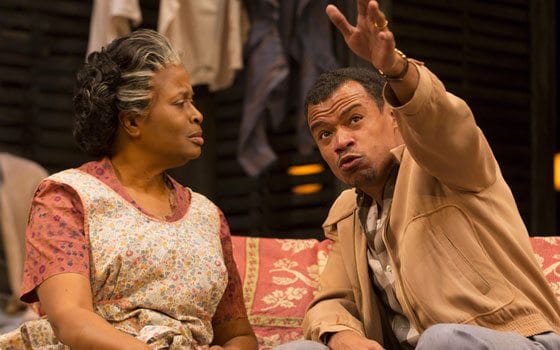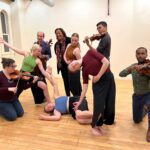
Joi Gresham. Choreographer, dancer, educator, professor and heir to the Lorraine Hansberry literary legacy. Hansberry wrote the groundbreaking play “A Raisin In The Sun,” which plays at the Hunington Theatre through Sunday. Joi Gresham grew up in an artistic and literary world in rural Croton-on-the Hudson, NY in the home of a literary giant and against the backdrop of the Civil Rights Movement. She has lived a life that most can only dream of. The daughter of Jewel Handy Gresham and Robert Nimeroff , Gersham is currently the executive director and a Trustee of the Lorraine Hansberry Literary Trust.
Joi’s eclectic upbringing began when her mother Jewel Handy married Broadway producer Robert Nimeroff, former husband of Lorraine Hansberry. Nimeroff married Hansberry in 1953 and although they divorced in 1962, they continued a close partnership.
Nimeroff came into Joi’s life when she was 10 and he adopted her as his daughter after his marriage to Jewel in 1967. Hansberry had passed away two years prior in 1965 at age 34 due to pancreatic cancer. Robert, Jewel and Joi all lived in Lorraine’s picturesque home, where Joi has fond memories of growing up.
“It was a mid-century house sort of ranch-style, all one level. And was built into a hill where the outdoors and indoors were continuous,” she said Even at age 10, I realized how special it was”.
There were little things of who she [Hansberry] was that reminded Joi of who she was. “Lorraine was the quintessential humanist with a wicked sense of humor,” she explains, “She had a little troll on her desk and she had clowns. She loved clowns.” Of the home itself, Gresham says “Lorraine chose the house as a sanctuary and as a place to write and to get away from all of the things that haunted her, drained her and prevented her from writing.”
Gresham lived in Croton-on-Hudson from age 10 to 17 until she left home to go to college. The house was sold in 2007 after her mother’s death in 2005 due to cancer. After both Nimeroff and her mother Jewel passed away, the role of literary executor passed to her.
At her Cambridge home Gresham recently opened up about her memories of the legacy and impact of “growing up Hansberry.”
How was it growing up with the legacy of Lorraine Hansberry?
On one hand it was amazing. It was an extraordinary experience, and don’t get me wrong, I always knew I was blessed to come into that inheritance. Lorraine came into my life and I into hers in 1966, when I was 10 years old. I was at an age where I was kind of clueless on what it meant at some level. I was young enough to be raised by Bob Nimeroff, my father. And, I grew up in this peculiar 1960s kind of extended family where Lorraine was everywhere. She was a part of the whole house.
During that time from when you were 10 to 17 years of age, did you understand the significance of being part of this living history?
I did. I was 11 when my parents actually married in 1967. In 1969, my father compiled a work based on Lorraine’s writings called “To Be Young, Gifted and Black”. It was staged Off Broadway. After it was staged, it was prepared and put into a book. It’s more of an autobiographical portrait of Lorraine’s writings and scribblings, photographs and artwork. The book was dedicated to me and my cousin and Lorraine’s cousin. I was 13 when the book came out and it was such a heady thing to happen to a 13-year-old. The spirit of “To Be Young, Gifted and Black” is about youth and the promise of that. I got that I was a part of this future she dreamed of.
With the Civil Rights Movement happening when you were growing up, how did that shape you?
Here’s a little more about the environment that I grew up in. Lorraine died in 1965. She was one of the voices of the early Civil Rights Movement. There was a famous meeting held with Bobby Kennedy when he was Attorney General in 1962 or 1963. He [Kennedy] assembled a group of black leaders to really be briefed and educated about the Civil Rights force coming on. I believe one of the key people was James Baldwin and he immediately thought of Lorraine. Lena Horne was there, Harry Belafonte and some other people from SNCC (Student Nonviolent Coordinating Committee) and CORE (Congress Of Racial Equality). They were all there and were trying to do their best for someone who wanted to know but didn’t really want to know about the fire and what was coming. She was a force of nature [at the meeting] and I wanted to be like Hansberry.
Was it a surprise to you to become executor of the estate when your mom passed?
I’m an only child and the expectation and the pressure of that expectation was pretty clear, pretty early on. And then I remember growing up and thinking about choices. My father made this choice and I didn’t know if I would make that choice. I started thinking about what I would need to make that choice. I was trained as a choreographer. I was a performing artist from when I was a very young girl and I grew up studying dance and performing. I was guided to do that by my parents who sought out the best teachers and training for me. And, that was what I was going to do and that was true until my mother’s death. I had a career as a college professor. I taught Arts education and African American studies. I performed and I choreographed. That was my life. I taught for about 25 years on the college level and I was looking for something different. I still wanted to be involved in theater and I needed to do something different. I came to the Boston area to teach at Lesley [College]. I thought about reentering the Hansberry world around the time of the “Raisin In the Sun” revival. [Her mother was responsible for the 2004 revival on Broadway with Phylicia Rashad, Sean “Diddy” Combs, Audra McDonald and Sanaa Lathan.]
Once you decided to continue on with your parents’ work, did you feel connected to your mother?
Absolutely. I also felt deeply connected to my father. It’s impossible to separate his and Lorraine’s work. He so deeply served the publishing of her work. When you go to the Schomburg Center in the archives section, they roll out these archive boxes. There are all these folders covered with the handwriting of my father. The only way I can go home on some level is to go to the Schomburg and see this stuff. It’s the only place that I can get a hit of all of it at once. It reminds me of being part of that whole experience. It helps me to connect and stay with those people and at the same time it was an incredible opportunity to know her.
Seeing that Hansberry wasn’t perfect, did it help you or shape you in your life? Has it given you a better understanding of her?
It has. It would be fair to say that I came to understand all those cultural and political leaders of those times who I identified with and looked up to as imperfect. At a certain point in your education, your exposure and in your own maturation you learn to do that as you would with your own parents. The purpose of that lesson is that you learn about your own shortcomings. You start to learn if you’re lucky what you can do to make a difference. I started to learn the difference between Lorraine and myself. Weeding out the fantasy. She was a contained being that had an incredible, short time on the planet and left this incredible legacy. At the same time, part of [that] legacy is you start in examining it to see what you’re supposed to do with it. It helps you to understand your role and what you can contribute. I’ve been learning. Every day I learn more of what I’m supposed to do. This combination of what Lorraine is asking me to do in her life and what I think is unfinished. I have an incredible job as the person who directs the trust and as a trustee, to keep completing Lorraine Hansberry. I’ve learned how to feel into what I’m supposed to do with it.
The Huntington Theatre Company presents “A Raisin in the Sun” through Sunday, April 7. Tickets are available online at www.huntingtontheatre.org by phone at (617) 266-0800 or in person at the BU Theatre Box Office.

![Banner [Virtual] Art Gallery](https://baystatebanner.com/wp-content/uploads/2024/04/NJ-H_1-150x150.jpg)


![Banner [Virtual] Art Gallery](https://baystatebanner.com/wp-content/uploads/2024/04/NJ-H_1-713x848.jpg)

